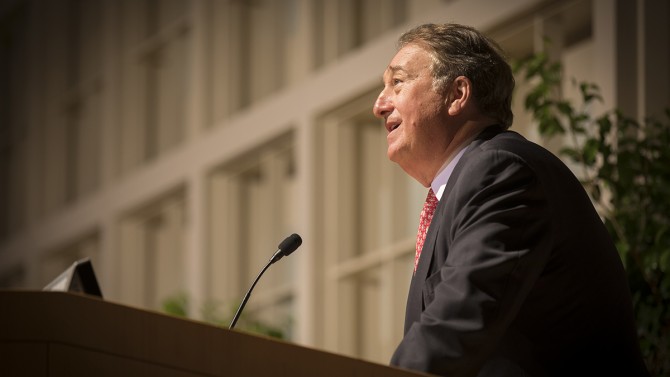
Gretchen Ritter ’83, the Harold Tanner Dean of Arts and Sciences, responds to a question from President Martha E. Pollack during the “Building Bridges Between Ithaca and Cornell Tech” panel discussion Oct. 19 in Statler Auditorium. Greg Morrisett, center, dean of the Faculty of Computing and Information Science, and Dan Huttenlocher, the Jack and Rilla Neafsey Dean of Cornell Tech, also participate in the discussion.
Milstein: Program will embrace long-held Cornell ethos
By Tom Fleischman
“Think differently” – it’s been a central theme at Cornell for more than 150 years and a driving force behind numerous educational initiatives including the new Cornell Tech campus, which opened this fall on Roosevelt Island in the heart of New York City.
While Cornell Tech is separated from Cornell’s Ithaca home by four hours and more than 200 miles, an increasingly digital world is bringing the campuses – and everything else on Earth – closer together. And thanks to the generosity of the Milstein family, including Howard ’73, his wife Abby and their son Michael ’11, another virtual bridge is being built.
Trustee-Council Annual Meeting/Homecoming weekend included a panel discussion, “Building Bridges Between Ithaca and Cornell Tech,” Oct. 19 in Statler Auditorium. The event was moderated by President Martha E. Pollack and featured the deans of the College of Arts and Sciences, Cornell Tech, and the Faculty of Computing and Information Science.
The evening was capped off with a short speech by Howard Milstein; it had been announced the previous day that the Milstein family has committed a $20 million gift to Cornell to create the Milstein Program in Technology and Humanity.
A collaboration between the College of Arts and Sciences and Cornell Tech, the undergraduate program will pioneer a new approach to developing 21st-century leaders and innovators. The program will be open to 25 students per class, beginning with the Class of ’22.
“The Milstein Program will set Cornell apart from its peers by bridging not only our two campuses, but the humanities, social sciences, computer science and technology,” Pollack said. “It will enhance our competitiveness in attracting top students, many of whom will aspire to enter the program. And it will serve as an inspiration for future Ithaca-Cornell Tech initiatives.”
Howard Milstein – who graduated summa cum laude with a degree in economics and has gone on to success in real estate, banking, hospitality, marketing, finance and technology – said he hopes the program will “introduce a new breed of people” to Cornell who “think differently – a long-standing Cornell tradition.”
Pollack gave a few opening remarks, thanking the Milsteins for their generosity to Cornell in this venture and in numerous others over the years. She then facilitated a discussion by posing questions to the assembled deans.
She began by asking each of the deans how they thought the Milstein Program would affect their particular areas.
“This [program] draws on so many things that are already great about Cornell,” said Gretchen Ritter ’83, the Harold Tanner Dean of Arts and Sciences. “It draws on the incredible strength of Arts and Sciences in preparing people to be historically oriented, to be broad, big-picture thinkers, and combines that with the orientation you get from Cornell Tech of being hands-on, interdisciplinary, of working in teams.”
“I actually think this is the perfect moment for this for Cornell Tech,” said Dan Huttenlocher, the Jack and Rilla Neafsey Dean of Cornell Tech. “We’re now at the stage where we have the mass, we have the faculty, we have the graduate students around the core programs. And to have this program be the first for Cornell undergraduates on campus is just tremendous.”
“Computer and information science has really revolutionized so many things in the 21st century,” said Greg Morrisett, dean of Computing and Information Science. “It doesn’t matter what field, it’s been revolutionized by computer science. And the students know that; they want to have a piece of that action. What’s important is to maintain the right kinds of balances. … These kinds of programs that bridge technology and arts and sciences are really, really exciting. That’s where the students want to be.”
Pollack asked Ritter about the impact of the digital age on the study of arts and sciences, then flipped the question around for Huttenlocher and Morrisett.
“For our students,” Ritter said, “this is the world they live in. They are already in many ways finding the path to pull together a computer and information science orientation with other fields.”
Huttenlocher said: “For probably 10 to 12 years and maybe longer, we’ve been a real leader in bringing into the computing sciences interactions with social sciences and the humanities. We were one of the earliest schools to start an information science department. Cornell’s been a real leader in that, and that’s really influenced hard-core computer scientists.”
One of the audience questions dealt with the admissions process for the Milstein Program, and that led to Ritter offering her perspective on the types of students she hopes it will attract. She said students will come from both freshman admissions and those who enter as sophomores.
“One of the reasons why that’s important,” she said, “is that not all of the students whom we would be excited about for this program will know coming in that that’s what they want to do. They might be a music major and get excited about the possibilities of what they can do with a more technical orientation.”
Milstein said he hopes the program that bears his family’s name will spawn a new way of thinking across all of Cornell.
“Imagine the impact on those who aren’t in the program,” he said, “who will be exposed to those 100 people who think differently.”
Media Contact
Get Cornell news delivered right to your inbox.
Subscribe